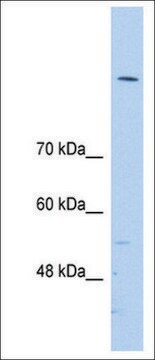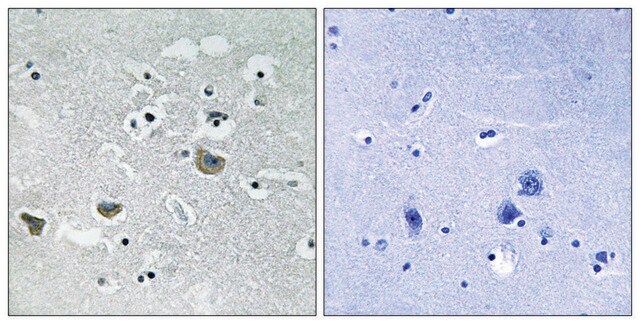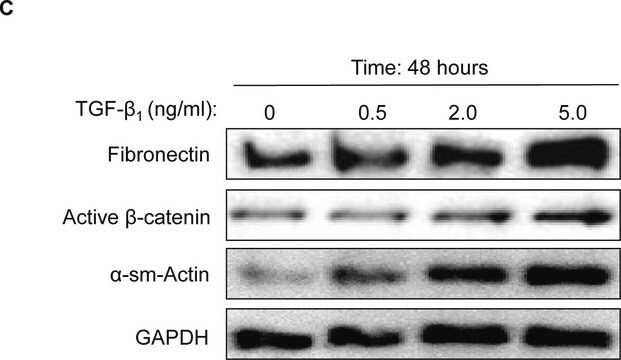추천 제품
생물학적 소스
rabbit
Quality Level
항체 형태
unpurified
항체 생산 유형
primary antibodies
클론
20B12, monoclonal
종 반응성
human
종 반응성(상동성에 의해 예측)
mouse (based on 100% sequence homology)
기술
western blot: suitable
동형
IgG
NCBI 수납 번호
UniProt 수납 번호
배송 상태
ambient
타겟 번역 후 변형
unmodified
유전자 정보
human ... SREBF1(6720)
일반 설명
Sterol regulatory element-binding protein 1 (UniProt: Q9WTN3; also known as SREBP-1, Sterol regulatory element-binding transcription factor 1) is encoded by the Srebf1 (also known as Srebp1) gene (Gene ID: 20787) in murine species. SREBPs are a family of transcription factors that regulate lipid homeostasis by controlling the expression of a range of enzymes that are required for endogenous cholesterol, fatty acid, triacylglyceride, and phospholipid synthesis. The three SREBP isoforms known as, SREBP-1a, SREBP-1c, and SREBP-2, have different roles in lipid synthesis. It has been reported that SREBP-1c is mainly involved in fatty acid synthesis and insulin induced glucose metabolism. SREBP-2 is mainly involved in cholesterol synthesis. SREBP-1a isoform is reported to be involved in both of these pathways. Isoform SREBP-1A predominates in spleen, while isoform IC predominates in liver, adrenal gland, brain and adipose tissue and both IA and IC are found in kidney, thymus, testis, muscle, jejunum, and ileum. Expression of SREBP-1C in the liver is reported to be controlled in a circadian manner with a peak at ZT16. SREBPs are synthetized as inactive precursor proteins that are bound to the endoplasmic reticulum membranes and upon activation, the precursor is cleaved off in a two-step process to release the N-terminal active domain in the nucleus. Sterols are shown to inhibit the cleavage of the precursor protein and the mature nuclear form is rapidly catabolized, thereby reducing transcription. SREBP-1 binds to the sterol regulatory element-1 (SRE1 5′-ATCACCCCAC-3′), which flanks the low density lipoprotein receptor gene and some genes involved in sterol biosynthesis. Mice overexpressing processed isoform SREBP-1A in adipocytes show enlarged white and brown adipocytes, increased rate of fatty acid synthesis and secretion leading to a fatty liver. Mice lacking isoform SREBP-1C show a lack of up-regulation of several lipogenic enzymes in response to high insulin or LXR activation. (Ref.: Eberle, D et al. (2004) Biochimie 86(11); 839-48).
특이성
Clone 20B12 recognizes SREBP-1 in multiple human tissues.
면역원
His-tagged recombinant fragment corresponding to 219 amino acids from the N-terminal region of murine sterol regulatory element-binding protein 1.
애플리케이션
Anti-SREBP-1, clone 20B12, Cat. No. MABS1987, a rabbit monoclonal antibody, detects SREBP-1 in human tissues by Western Blotting.
Research Category
Signaling
Signaling
Western Blotting Analysis: A 1:1,000 dilution from a representative lot detected SREBP-1 in 10 µg of HEK293 cell lysates.
품질
Evaluated by Western Blotting in HepG2 cell lysates.
Western Blotting Analysis: A 1:1,000 dilution of this antibody detected SREBP-1 in 10 µg of HepG2 cell lysates.
Western Blotting Analysis: A 1:1,000 dilution of this antibody detected SREBP-1 in 10 µg of HepG2 cell lysates.
표적 설명
~120 kDa observed; 120.54 kDa calculated. Uncharacterized bands may be observed in some lysate(s).
물리적 형태
Format: Unpurified
Rabbit monoclonal antibody in cell culture supernatant without azide.
Unpurified
저장 및 안정성
Stable for 1 year at -20°C from date of receipt. Handling Recommendations: Upon receipt and prior to removing the cap, centrifuge the vial and gently mix the solution. Aliquot into microcentrifuge tubes and store at -20°C. Avoid repeated freeze/thaw cycles, which may damage IgG and affect product performance.
기타 정보
Concentration: Please refer to lot specific datasheet.
면책조항
Unless otherwise stated in our catalog or other company documentation accompanying the product(s), our products are intended for research use only and are not to be used for any other purpose, which includes but is not limited to, unauthorized commercial uses, in vitro diagnostic uses, ex vivo or in vivo therapeutic uses or any type of consumption or application to humans or animals.
적합한 제품을 찾을 수 없으신가요?
당사의 제품 선택기 도구.을(를) 시도해 보세요.
Storage Class Code
10 - Combustible liquids
WGK
WGK 2
시험 성적서(COA)
제품의 로트/배치 번호를 입력하여 시험 성적서(COA)을 검색하십시오. 로트 및 배치 번호는 제품 라벨에 있는 ‘로트’ 또는 ‘배치’라는 용어 뒤에서 찾을 수 있습니다.
MiSung Kim et al.
JCI insight, 2(24) (2017-12-22)
Increased sugar consumption is a risk factor for the metabolic syndrome including obesity, hypertriglyceridemia, insulin resistance, diabetes, and nonalcoholic fatty liver disease (NAFLD). Carbohydrate responsive element-binding protein (ChREBP) is a transcription factor that responds to sugar consumption to regulate adaptive
Kyounghee Min et al.
eLife, 12 (2024-04-02)
Circulating lactate is a fuel source for liver metabolism but may exacerbate metabolic diseases such as nonalcoholic steatohepatitis (NASH). Indeed, haploinsufficiency of lactate transporter monocarboxylate transporter 1 (MCT1) in mice reportedly promotes resistance to hepatic steatosis and inflammation. Here, we
Hong Lu et al.
Lipids in health and disease, 21(1), 46-46 (2022-05-26)
Hepatocyte nuclear factor 4α (HNF4α) and glucocorticoid receptor (GR), master regulators of liver metabolism, are down-regulated in fatty liver diseases. The present study aimed to elucidate the role of down-regulation of HNF4α and GR in fatty liver and hyperlipidemia. Adult
Junhee Park et al.
Nature communications, 13(1), 5594-5594 (2022-09-24)
Insulin receptor (IR) signaling defects cause a variety of metabolic diseases including diabetes. Moreover, inherited mutations of the IR cause severe insulin resistance, leading to early morbidity and mortality with limited therapeutic options. A previously reported selective IR agonist without
Antwi-Boasiako Oteng et al.
Molecular nutrition & food research, 63(19), e1900385-e1900385 (2019-07-22)
The mechanisms underlying the deleterious effects of trans fatty acids on plasma cholesterol and non-alcoholic fatty liver disease (NAFLD) are unclear. Here, the aim is to investigate the molecular mechanisms of action of industrial trans fatty acids. Hepa1-6 hepatoma cells
자사의 과학자팀은 생명 과학, 재료 과학, 화학 합성, 크로마토그래피, 분석 및 기타 많은 영역을 포함한 모든 과학 분야에 경험이 있습니다..
고객지원팀으로 연락바랍니다.








